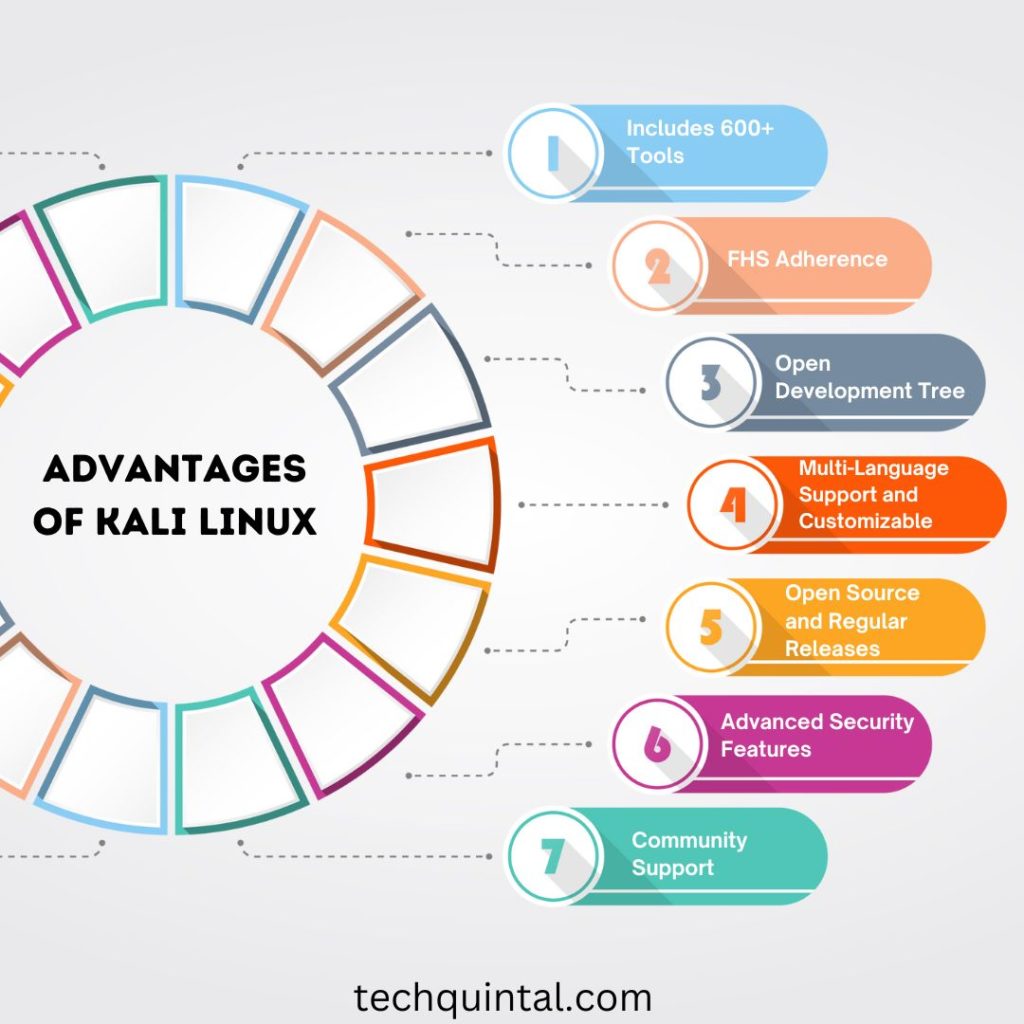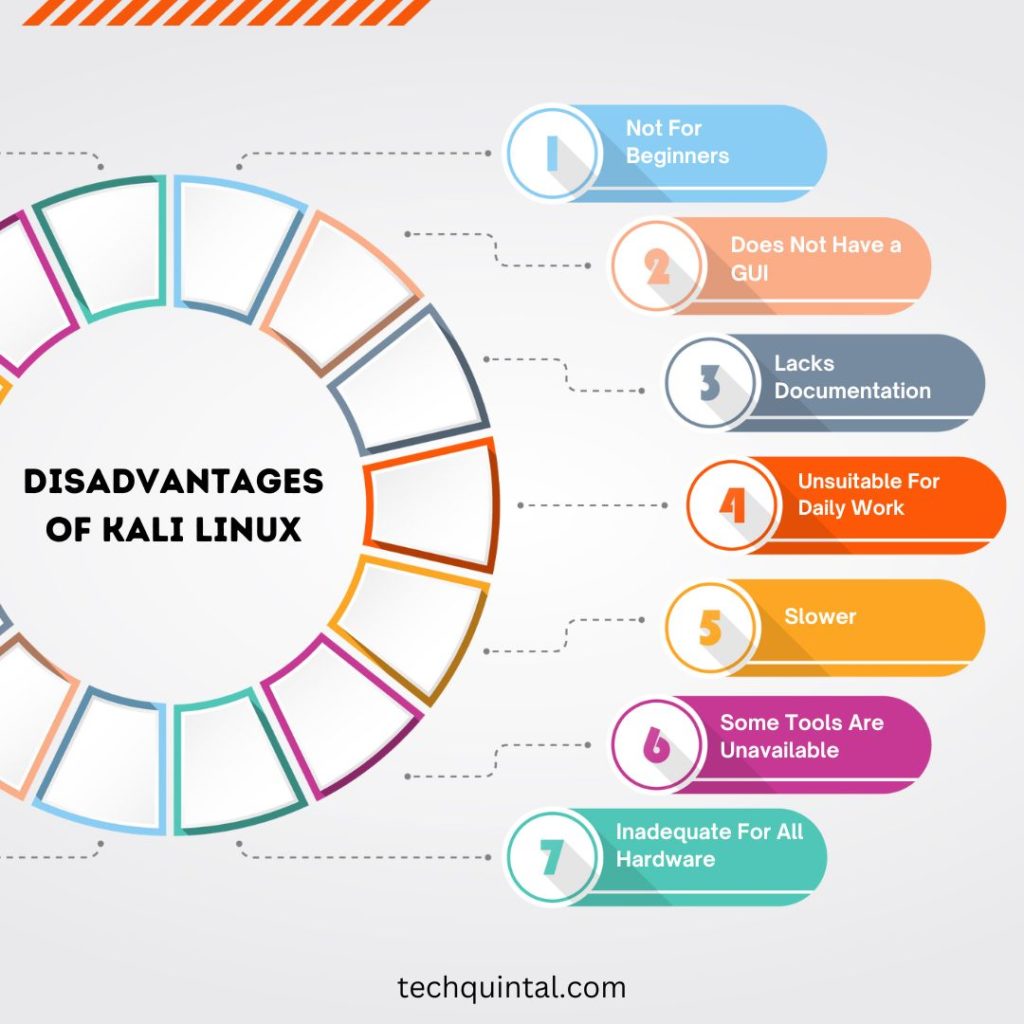
Kali Linux is a Debian-based distribution that includes security and penetration testing tools. It is developed and maintained by Offensive Security. The operating system is designed for penetration testers, network analysts, or in other words, cybersecurity and analysis professionals. Kali Linux became especially well-known after being mentioned in the “Mr. Robot TV” series. It’s not for beginners; rather, it’s adequate for experts who know Linux and its distributions and are familiar with the way they work already. Since it has a lot to offer to advanced users and ethical hackers, there is little use for novices.
Kali Linux Overview
When we talk about operating systems like Kali Linux, we need to have a techy mind to understand how it works and what it really does. It is time for you to not get confused whenever you hear the word in the future as we are going to tell you the right definition of this operating system and what it is used for. Basically, Kali Linux is one of the most powerful and advanced operating systems that is mainly used for ethical hacking and security research.
As you can guess by the name, it is based on the Linux operating system. But it does not operate entirely in that manner as it comes with a collection of security and forensic tools that are pre-installed.
Kali Linux was actually developed by a leading information security training company called Offensive Security. This operating system is not meant for beginners. It can be operated well by only those who are computer heads and have a deep understanding of network security and computer systems.
Now, if you are thinking about who should actually operate this system, then the answer is simple. If you are a security expert who wants to conduct in-depth and advanced analysis of computer systems to improve security, Kali Linux is your go-to platform.
History of Kali Linux
It is the product of Mati Aharoni and Deavon Kearns, who are core contributors to the project. Backtrack Linux was a modification of another penetration testing-focused Linux distribution called Backtrack Linux. The development of Kali follows Debian guidelines since it relies on a large portion of its code from Debian archives.
The development began in March 2012 among a small group of developers. Only a select few developers were permitted to submit packages in a secure environment. It is a versatile operating system that can be used for many purposes. Some include penetration testing, security research, computer forensics, and reverse engineering.
Kali Linux Features
It has a wide range of tools available to help accomplish these tasks. One of the most notable features of Kali Linux is its ability to run entirely from RAM. This means that once booted into Kali, all changes made to the system are reverted once it is rebooted. This is useful for working in areas where write access to storage devices is not possible or desirable, as any changes made will not persist.
Kali Linux also features a custom kernel specially tailored for security purposes. This kernel includes extra security features and hardening patches not included in the mainline kernel.
- Open-source software with regular updates.
- Advanced Penetration Testing tools.
- Multi-language support.
- Supports a wide range of wireless devices.
- Customizable User Interface.
- Forensics mode available.
- Secure and versatile.
- Live boot capability.
- Extensive documentation and community support.
- Powerful coding and scripting tools.
With that said, let’s explore some advantages and disadvantages of Kali Linux.
Advantages of Kali Linux

For intermediate Linux users, Kali is ideal, so let’s look at some benefits of this most advanced penetration testing distribution. These are the advantages of Kali Linux:
1. Kali Linux includes 600+ Tools for Testing Penetration
There are more than 600 penetration-testing tools in Kali Linux, all created to make it easier for network security professionals to check the safety of their networks. These include basic information-gathering and reporting tools.
The goal of including so many capabilities is to ensure that nothing is overlooked. With the help of the Meta Packages, you can install the tools that are most crucial to your job. Another feature you will enjoy is the Version Tracking tool, which allows you to compare different versions of Kali to what you are currently using.
2. Its FHS Adherence
Users can find help files, executables, and even libraries on all File-System Hierarchy Standard (FHS)-compliant systems. You won’t have to look for a tool manually since you wouldn’t need to with BackTrack. Simply type the command name of the tool into the root terminal in Kali Linux and voilà.
3. Open Development Tree
Many products are made even better by the availability of free, open-source software, as proven by Kali Linux. Consequently, anyone can inspect the source codes and gain quick access to the system. The open-source development tree also allows you to document each stage.
4. Multi-Language Support
Although most penetration tools are in English, Kali has comprehensive multilingual support, allowing more people to work in their native language and locate necessary utilities.
5. It is Customizable
It’s simple to create a unique version of Kali for our needs using meta-packages and a highly accessible ISO file customization approach. The live-build feature in Kali Linux permits users to modify the images as they wish and see the changes.
6. It’s Open Source and Has Good Platform Support
Kali Linux is a free and open-source operating system with no hidden costs. It has no proprietary software or drivers. Kali Linux is available for VirtualBox, VMware, Raspberry Pi, ARM images, and cloud instances. It can run on x86 systems and ARM-based devices such as the Odroid or the PandaBoard.
7. Regular Releases
Each Kali release undergoes an extensive testing process to ensure that it meets the needs of penetration testers and security professionals around the world. We can also expect routine updates and new features with each release.
8. Advanced Security Features
Kali’s Linux kernel has many state-of-the-art security components not found in other distributions. These include Address Space Layout Randomization (ASLR), ExecShield, and NX bit, to name a few.
9. Community Support
Kali Linux has an active and friendly community that is always willing to help. There are many forums and IRC channels where users can ask questions and get help from others. Content creators are also motivated to cover this niche.
Disadvantages of Kali Linux

There are a handful of drawbacks to Kali Linux that users should be aware of. The following are the disadvantages of Kali Linux:
1. Kali Linux is not intended for Beginners and Doesn’t Have a GUI
Kali Linux is not for beginners. It is a penetration testing distribution meant for experienced users. If you are new to Linux, you will find it difficult to use it. Also, the operating system lacks a graphical user interface (GUI). This means that all tasks must be done from the command line. For some people, this may be too difficult.
2. Lacks Documentation and is Unsuitable for Daily Work
There is very little documentation available for Kali Linux. This can make it difficult to learn how to use all available tools. Kali Linux is not meant to be used as your everyday operating system. Again, it’s designed for penetration testing and security analysis. If you try to use it for everyday tasks, you will find it complex.
3. It’s a Little Slower and Some Tools are Unavailable
Kali Linux is a bit slower than other distributions because it uses many resources for penetration testing tools. Some tools available in other distributions, such as Fedora and Ubuntu, are not available in Kali Linux. This can be a problem if you need to use those for your work.
4. Inadequate for all Hardware and Has Bugs and Security Vulnerabilities
Kali Linux is not suitable for all hardware. Some devices, such as smartphones and tablets, cannot run Kali Linux. Also, since Kali Linux is based on Debian, it has the same bugs and security vulnerabilities as that operating system. This means that the system is not as secure as it could be.
Uses of Kali Linux
The world of Kali Linux can be a little too technical for beginners, but it does not mean it is not interesting. Kali Linux is used for a lot of things that we will try to explain to you in simple language. These are the uses of Kali Linux:
- Security Auditing: Kali Linux is equipped with tools for network and application security auditing. If you are a security professional or an ethical hacker, these tools can come very handy. They can be used to discover vulnerabilities in systems and applications.
- Penetration Testing: Penetration testing is one of the most fun uses of Kali Linux for developers. Users use it for penetrating systems where they try to find any vulnerabilities. The testers cyberattack on various systems to exploit what can be exploited.
- Digital Forensics: Kali Linux is not only used for cyberattacking, but it also includes tools for digital forensics. It aids in the investigation of digital crimes and the recovery of data from digital devices.